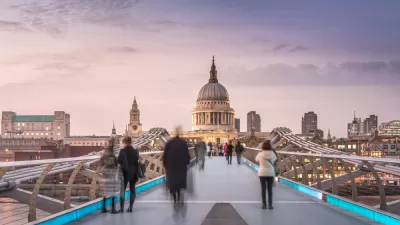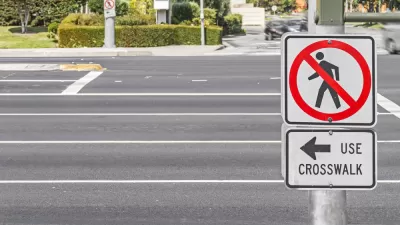San Diego's downtown street grid features smaller blocks than almost all other major U.S. cities. Small blocks mean more intersections, less distance between them, and a lot of interrupted bipedaling. Bill Adams reviews some potential fixes.

Walking from point A to point B in downtown San Diego, whether for exercise or for a more utilitarian purpose, can be a frustrating experience, notes San Diego land use attorney and downtown denizen Bill Adams.
"San Diego’s downtown street grid and its small blocks make continuous walking difficult, especially for people trying to go in a straight line. Jogging is even more difficult. The blocks are 200 by 300 feet. Among major cities, only Portland has smaller blocks at 200 by 200 feet. So depending on walking direction, pedestrians generally must stop every 200 or 300 feet to wait for traffic. . ."
"Today, the uniform small blocks and 75 foot wide one-way roads maximize the automobile’s domain and undermine the walkability of downtown. The problem is made even worse by San Diego’s $100 plus jaywalking tickets (about twice that of a parking ticket – another pro-auto bias?)."
However, small blocks and many intersections don't need to need to mean interrupted walking, notes Adams citing Portland. He reviews some of the methods tried elsewhere for suitability in San Diego, from shared space to pedestrian only streets.
FULL STORY: Why Downtown San Diego Pedestrians Stop for Cars More Than Any Other City and What to do About it.

Alabama: Trump Terminates Settlements for Black Communities Harmed By Raw Sewage
Trump deemed the landmark civil rights agreement “illegal DEI and environmental justice policy.”

Study: Maui’s Plan to Convert Vacation Rentals to Long-Term Housing Could Cause Nearly $1 Billion Economic Loss
The plan would reduce visitor accommodation by 25% resulting in 1,900 jobs lost.

Planetizen Federal Action Tracker
A weekly monitor of how Trump’s orders and actions are impacting planners and planning in America.

Wind Energy on the Rise Despite Federal Policy Reversal
The Trump administration is revoking federal support for renewable energy, but demand for new projects continues unabated.

Passengers Flock to Caltrain After Electrification
The new electric trains are running faster and more reliably, leading to strong ridership growth on the Bay Area rail system.

Texas Churches Rally Behind ‘Yes in God’s Back Yard’ Legislation
Religious leaders want the state to reduce zoning regulations to streamline leasing church-owned land to housing developers.
Urban Design for Planners 1: Software Tools
This six-course series explores essential urban design concepts using open source software and equips planners with the tools they need to participate fully in the urban design process.
Planning for Universal Design
Learn the tools for implementing Universal Design in planning regulations.
Caltrans
Smith Gee Studio
Institute for Housing and Urban Development Studies (IHS)
City of Grandview
Harvard GSD Executive Education
Toledo-Lucas County Plan Commissions
Salt Lake City
NYU Wagner Graduate School of Public Service




























